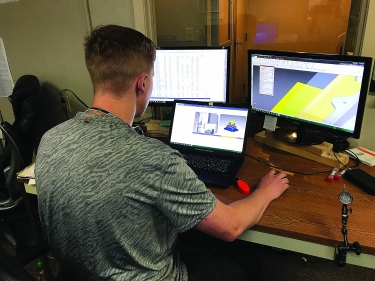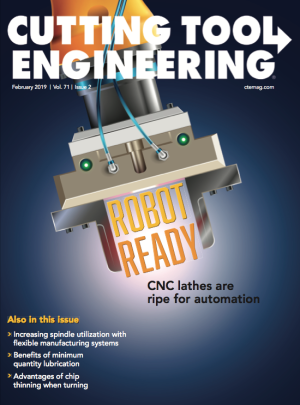For three decades and two generations, family-owned Jemco Components & Fabrication Inc. has offered prototype and production machining, fabrication and assembly services, laser marking and etching and a host of finishing options.
Three years ago, as the Kirkland, Washington-based contract manufacturer’s amount of 5-axis machining grew, management determined that an increasing number of little crashes potentially could lead to one big crash, which might damage an expensive machine tool and disrupt deliveries to customers.
With more than two dozen 5-axis machining centers in use, Vice President Travis Moore and his team began looking for an alternative to the traditional push-the-green-button-and-pray program prove-outs. In the end, the manufacturer turned to Vericut machine simulation software from CGTech Inc., Irvine, California.

Jemco Components & Fabrication uses Siemens NX CAD/CAM software but finds Vericut an invaluable tool for preventing crashes. image courtesy of Jemco Components & Fabrication
“A number of companies tried very hard to sell us on their simulation software,” Moore said, “telling us how their solution would address all of our needs. But after a lot of research and talking to a number of people, we found that Vericut was the only software with true G-code simulation.”
On the market since 1988, Vericut reads the code used by a machine controller, picking up where CAM systems leave off. Every workpiece, fixture, toolholder and machine component can be accurately modeled so nothing is left to chance. Gouging and uncut areas are clearly identified. Setup times are reduced. Because complete visibility of the machining process is achieved, opportunities for process improvement are enhanced. Best of all, collisions are virtual rather than spark-filled and noisy.
Moore’s parents founded Jemco when he was a child. Their decision to pursue sheet metal fabrication and machining under the same roof was made at the outset with the purchase of a Finn-Power turret punch press and an Okuma Cadet machining center.
In its machine shop, Jemco has nearly 40 CNC lathes and machining centers. Equipment builders include Haas, Okuma, Mazak and others, but topping the list is a pair of DMG Mori NMV 1500 5-axis vertical machining centers—one sporting a 40,000-rpm spindle—serviced by a 34-pallet robotic cell material-handling system.
“We try to be really diverse,” Moore said. “My dad saw from the very beginning that there was value in having a one-stop shop. There are plenty of complex fab parts that require milling, and he felt that managing both was something he could do fairly easily. It’s been smooth sailing ever since.”
Part of that smooth journey, at least recently, has been due to Vericut.
“All those little crashes we were seeing have died down to nothing,” Moore said. “That’s saying a lot because most of our production quantities are small—between two and two dozen pieces—and we therefore set up many jobs each day. As anyone in this business will tell you, the more times you’re setting up, the more opportunities you have to mess up. I strongly tie our lack of crashes to Vericut.”
Having lots of jobs means having lots of programmers. Jemco has seven, each with his or her own way of doing things. CNC Programmer Chuck Macomb said Vericut helps answer the many questions that arise when generating toolpaths.
“Is there any interference between the toolholders and the vise?” he asked. “Did the program cut the part right? Is the spindle going to bump the workpiece? Did each axis go the direction you expected it to? There are all kinds of problems that can occur. But because the CAM software doesn’t see the same thing the machine sees, there can be occasional surprises. Vericut eliminates the wondering.”
CNC Programmer Tony Maldonado agreed.
“We use Siemens NX for our CAM platform here,” he said. “It does a good job on most parts of telling you if you’re going to crash or violate the part in any way, but you have to pay close attention to see it. Sometimes things are moving so fast that it’s easy to miss something, and that’s where Vericut comes in. You can see any areas that you missed during programming, any gouges and especially any crashes.”
Related Glossary Terms
- centers
centers
Cone-shaped pins that support a workpiece by one or two ends during machining. The centers fit into holes drilled in the workpiece ends. Centers that turn with the workpiece are called “live” centers; those that do not are called “dead” centers.
- chuck
chuck
Workholding device that affixes to a mill, lathe or drill-press spindle. It holds a tool or workpiece by one end, allowing it to be rotated. May also be fitted to the machine table to hold a workpiece. Two or more adjustable jaws actually hold the tool or part. May be actuated manually, pneumatically, hydraulically or electrically. See collet.
- computer numerical control ( CNC)
computer numerical control ( CNC)
Microprocessor-based controller dedicated to a machine tool that permits the creation or modification of parts. Programmed numerical control activates the machine’s servos and spindle drives and controls the various machining operations. See DNC, direct numerical control; NC, numerical control.
- computer-aided manufacturing ( CAM)
computer-aided manufacturing ( CAM)
Use of computers to control machining and manufacturing processes.
- fixture
fixture
Device, often made in-house, that holds a specific workpiece. See jig; modular fixturing.
- gang cutting ( milling)
gang cutting ( milling)
Machining with several cutters mounted on a single arbor, generally for simultaneous cutting.
- machining center
machining center
CNC machine tool capable of drilling, reaming, tapping, milling and boring. Normally comes with an automatic toolchanger. See automatic toolchanger.
- milling
milling
Machining operation in which metal or other material is removed by applying power to a rotating cutter. In vertical milling, the cutting tool is mounted vertically on the spindle. In horizontal milling, the cutting tool is mounted horizontally, either directly on the spindle or on an arbor. Horizontal milling is further broken down into conventional milling, where the cutter rotates opposite the direction of feed, or “up” into the workpiece; and climb milling, where the cutter rotates in the direction of feed, or “down” into the workpiece. Milling operations include plane or surface milling, endmilling, facemilling, angle milling, form milling and profiling.
- sawing machine ( saw)
sawing machine ( saw)
Machine designed to use a serrated-tooth blade to cut metal or other material. Comes in a wide variety of styles but takes one of four basic forms: hacksaw (a simple, rugged machine that uses a reciprocating motion to part metal or other material); cold or circular saw (powers a circular blade that cuts structural materials); bandsaw (runs an endless band; the two basic types are cutoff and contour band machines, which cut intricate contours and shapes); and abrasive cutoff saw (similar in appearance to the cold saw, but uses an abrasive disc that rotates at high speeds rather than a blade with serrated teeth).
- toolholder
toolholder
Secures a cutting tool during a machining operation. Basic types include block, cartridge, chuck, collet, fixed, modular, quick-change and rotating.


